UNIT2:Climate Change and Wildlife Protection
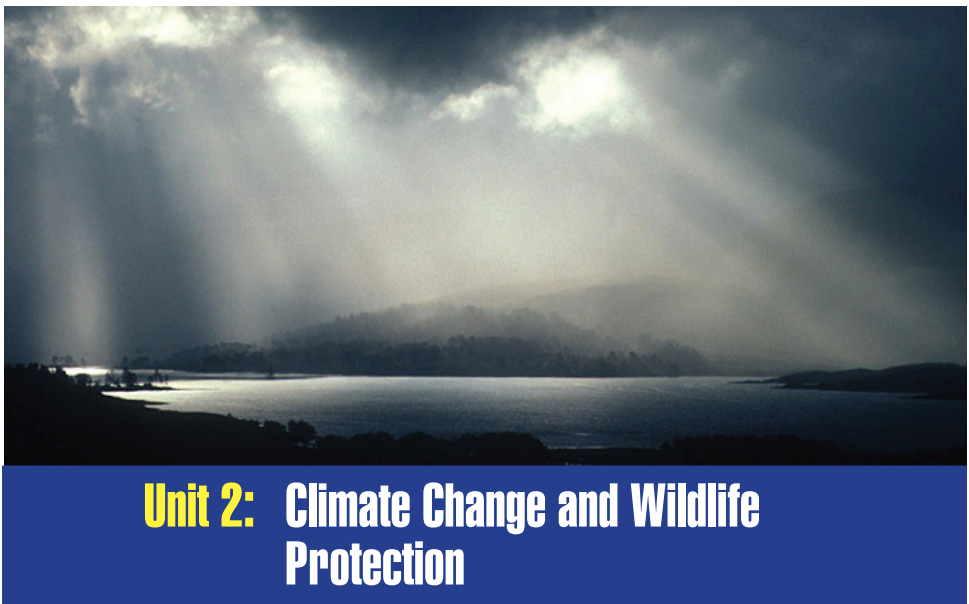
Introductory activity: Read the following text and answer
questions below:
Impact of climate change on human health
The impacts of climate change include warming temperatures, changes
in precipitation, increases in the frequency or intensity of some extreme
weather events, and rising sea levels. These impacts threaten our health by
affecting the food we eat, the water we drink, the air we breathe, and the
weather we experience.
The severity of these health risks will depend on the ability of public health
and safety systems to address or prepare for these changing threats, as well
as factors such as an individual’s behavior, age, gender, and economic status.
Impacts will vary based on where a person lives, how sensitive they are to
health threats, how much they are exposed to climate change impacts, and
how well they and their community are able to adapt to change.
People in developing countries may be the most vulnerable to healthrisks globally, but climate change poses significant threats to health even
in wealthy nations such as the United States. Certain populations, such as
children, pregnant women, older adults, and people with low incomes, face
increased risks.
Warmer average temperatures will lead to hotter days and more frequent
and longer heat waves. These changes will lead to an increase in
heatrelated deaths in the United States—reaching as much as thousands to tens
of thousands of additional deaths each year by the end of the century during
summer months.
These deaths will not be offset by the smaller reduction in cold-related deaths
projected in the winter months. However, adaptive responses, such as wider
use of air conditioning, are expected to reduce the projected increases in
death from extreme heat.
Exposure to extreme heat can lead to stroke and dehydration, as well as
cardiovascular, respiratory, and cerebrovascular disease. Excessive heat is
more likely to affect populations in northern latitudes where people are less
prepared to cope with excessive temperatures. Certain types of populations
are more vulnerable than others: for example, outdoor workers, student
athletes, and homeless people tend to be more exposed to extreme heat
because they spend more time outdoors.
Additionally, younger children, pregnant women, older adults, and
people with certain medical conditions are less able to regulate their bodytemperature and can therefore be more vulnerable to extreme heat.
Comprehension questions
1. Identify different impacts of climate change.
2. Explain how climate change impacts affect human health.
3. Which factors increase the severity of the climate change impacts
on human health?
4. What are the consequences of extreme climate changes? How can
these consequences be averted?
5. What are different diseases caused by extreme heat?6. What group of people that are mostly affected by excessive heat?
Vocabulary
Use each of the following words in your own sentence.
a) Precipitation
b) sea levels
c) severity
d) threats
e) vulnerable
f) longer heat waves
g) offset
h) stroke
i) dehydrationj) cerebrovascular disease
Application activity
Debate on the following motion:Areas with cold climate favors health more than those with hot climate
Language use: Describing climate
change
Describing climate change
Activity 1
1. Work with a classmate.
2. Look outside your classroom. In turns describe the weather you
see. Does the weather sometimes change?
3. Are there times when you experience very hot weather as opposed
to cold weather?4. What do you think brings about these weather changes?
Activity 2
Read the passage below carefully
Climate change is already beginning to transform life on Earth. Around
the globe, seasons are shifting, temperatures are increasing and sea levels
are rising. And meanwhile, our planet must still supply us – and all
living things – with air, water, food and safe places to live. If we don’t
act now, climate change will rapidly alter the lands and waters we all
depend upon for survival, leaving our children and grandchildren with
a very different world.
Heat-trapping gases emitted by power plants, automobiles, deforestation
and other sources are warming up the planet. In fact, the five hottest
years on record have all occurred since 1997 and the 10 hottest since1990, including the warmest years on record – 2005 and 2010.
Climate Change Impacts: Higher Temperatures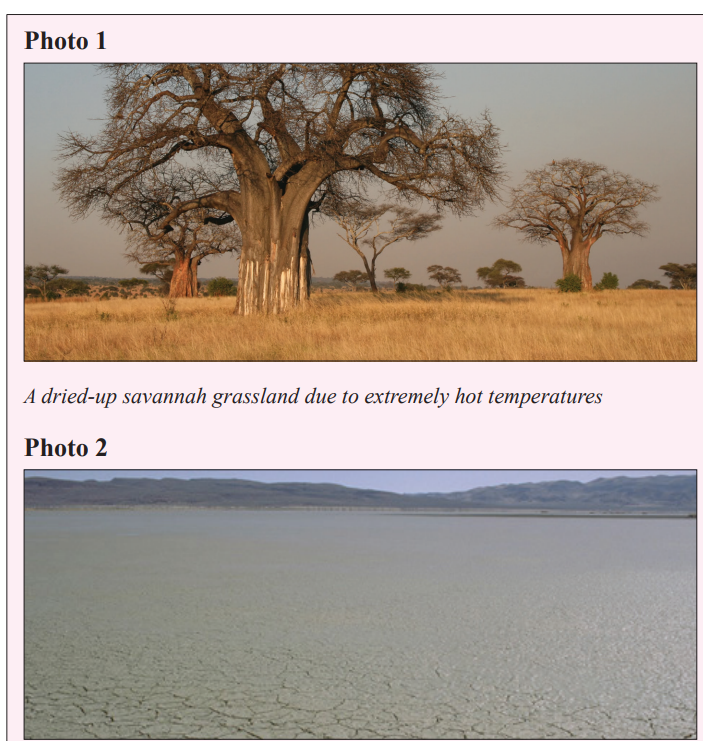
High temperatures are to blame for an increase in heat-related deaths
and illness, rising seas, increased storm intensity, and many of the other
dangerous consequences of climate change.
During the 20th century, the Earth’s average temperature rose one degree
Fahrenheit to its highest level in the past four centuries – believed to be
the fastest rise in a thousand years.
Scientists project that if emissions of heat-trapping carbon emissions
aren’t reduced, average surface temperatures could increase by 3 to 10degrees Fahrenheit by the end of the century.
A one-degree increase may be found in one place, a 12-degree increase
in another place, and yet other areas may become much colder.
The planet’s oceans are also warming, which is causing dangerous
consequences such as stronger storms, coral bleaching and rising seas.
Exercise
Answer these questions about the passage
1. Cite examples from the passage to explain what you understand
by climate change.
2. Explain how climate change alters the land.
3. How are industrial processes responsible for climate change?
4. Explain what carbon emissions are and describe what would
happen if heat-trapping carbon emissions are not reduced.
5. Look at photograph 2 of a lake that dried. What does this situation
teach you about humans checking their negative responsiveness
to the environment?
6. Some of the most dangerous consequences of climate change are
mentioned in the passage. Which one will have the most seriousimpact on our lives, or on the places we care about?
Activity 3
Vocabulary practice
Identify new words from the passage you are not familiar with. Find
their meaning either from a dictionary or ask your Geography teachers.
Form your own sentences using the words and phrases to show that
you have understood their meaning.
Describing climate change
In the previous lesson, in the reading section, we learnt about climate
change and concluded that if we do not check our human actions towardsthe environment, we are headed for doom.
Activity 4
Discussion
Share your opinions about these questions.
1. Explain the effects you think climate change can cause on our
natural resources like land, forests, animals, the air we breathe
and our water resources.
2. Suggest what you think should be done to protect these resources.
3. How about humans and other lives in general; what do you predict
will happen to us as a result of climate change?
Choose a secretary to present your findings to the class for furtherdiscussion and comparison of your views
Climate Change Impacts: Changing Landscapes
Activity 5
Study the photograph carefully and use it to explain the
effect of climate change on the land. What consequences
will follow in relation to food supply and human survival?Photo 3

Activity 6
Practice, and act out the dialogue for the class.
Justine: Hello Bruce. I’m most concerned that changing
temperatures are causing vegetation shifts and
conservation challenges.
Bruce: Indeed. Rising temperatures and changing patterns of rain
and snow are forcing trees and plants around the world
to move towards polar regions and up mountain slopes.
Justine: What do you predict will be the outcome of these drastic
changes?
Bruce: These vegetation shifts will undermine much of the
work the conservation community has accomplished to
date, with the potential to permanently change the face
of conservancy preserves, local land trusts, and even our
national parks.
Justine: That’s for real because in our geography lessons today we
were looking at how in the tundra, thawing permafrost
will allow shrubs and trees to take root. In the Great
Plains of the United States, grasslands will likely become
forests. And New England’s fiery fall foliage will
eventually fade as maple and beech forests shift north
towards cooler temperatures.
Bruce: The case is no different here in Africa; the average
temperature of the earth has risen in the last decade.
Since the last century, the snow on Mount Kilimanjaro
has tremendously reduced. The temperatures have risen.It is really a pity
Justine: And I guess wildlife has migrated to other areas.
Bruce: Oh, that is for sure! As plant communities try to adjust
to the changing climate by moving towards cooler areas,
the animals that depend on them will be forced to move.
Development and other barriers may block the migration
of both plants and animals.
In fact, some species that may not adapt to the new
environment will die.
Justine: Oh no! That is absurd. Our treasured wildlife is at risk!What should we do to rectify this precarious situation?
Activity 7
Composition
Write an essay that answers the last statement by Justine on what should
be done to solve the climate change problems in the dialogue. Exchange
your essays for comparison and discussion of your views.
Predicting the effects of climate change
Activity 1
Work together
From all the passages you have so far read in this unit about climate
change, give your prediction about what might or could occur in thefuture if global warming persists.
Activity 2
Read the passage belowClimate Change Impacts: Rising Seas, Higher Sea Levels
The rise of sea levels due to climate change could displace tens of millions
of people.
As the Earth heats up, sea levels rise because warmer water takes up
more room than colder water, a process known as thermal expansion.
Melting glaciers compound the problem by dumping even more fresh
water into the oceans.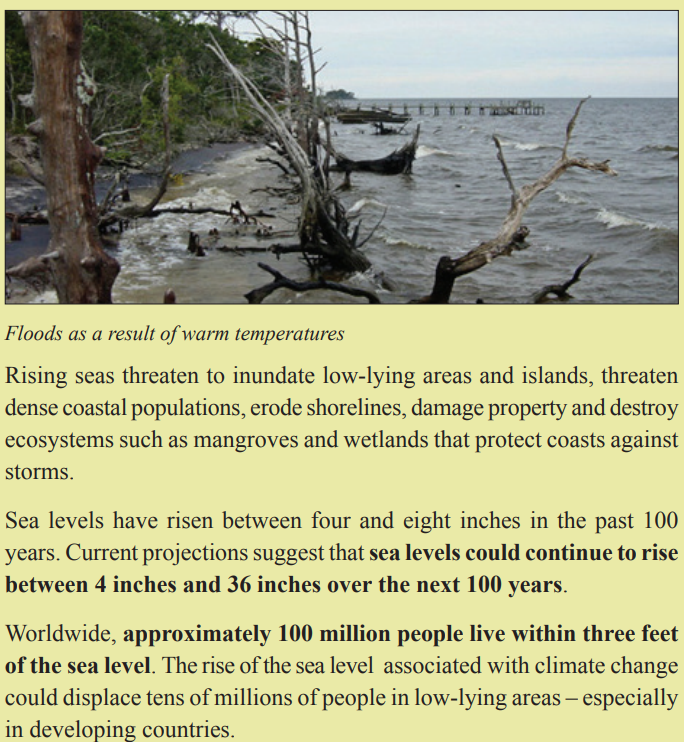
Inhabitants of some small island countries that rest barely above the
existing sea level are already abandoning their islands, some of theworld’s first climate change refugees.
Climate Change Impacts: Increased Risk of Drought,Fire, and Flood
Climate change is making floods, fires and droughts more frequent and severe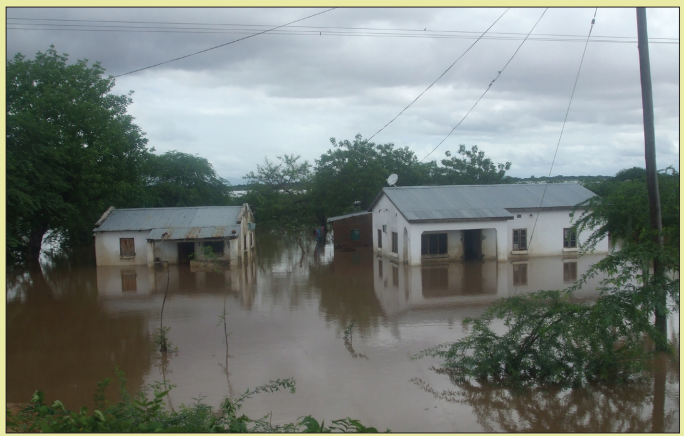
Climate change is intensifying the circulation of water on, above and
below the surface of the Earth — causing drought and floods to be more
frequent, severe and widespread.
Higher temperatures increase the amount of moisture that evaporates
from land and water, leading to drought in many areas. Lands affected
by drought are more vulnerable to flooding once rain falls.
As temperatures rise globally, droughts will become more frequent and
more severe, with potentially devastating consequences for agriculture,
water supply and human health. This phenomenon has already been
observed in some parts of Asia and Africa, where droughts have become
longer and more intense.
Hot temperatures and dry conditions also increase the likelihood of
forest fires.
Climate change will cause storms, hurricanes and tropical storms to become
more intense
Scientific research indicates that climate change will cause hurricanes
and tropical storms to become more intense — lasting longer, unleashing
stronger winds, and causing more damage to coastal ecosystems and
communities.
Scientists point to higher ocean temperatures as the main culprit, since
hurricanes and tropical storms get their energy from warm water. As sea
surface temperatures rise, developing storms will contain more energy.
At the same time, other factors such as rising sea levels, disappearing
wetlands, and increased coastal development threaten to intensify thedamage caused by hurricanes and tropical storms.
Climate Change Impacts: Heat-Related Illness and Disease
Climate change brings health risks to the world’s most
vulnerable communities.
As temperatures rise, so do the risks of heat-related illness and even
death for the most vulnerable human populations.
In 2003, for example, extreme heat waves caused more than 20,000 deaths
in Europe and more than 1,500 deaths in India. Scientists have linked thedeadly heat waves to climate change and warn of more to come
In addition to heat-related illness, climate change may increase the
spread of infectious diseases, mainly because warmer temperatures
allow disease-carrying insects, animals and microbes to survive in areas
where they were once thwarted by cold weather.
Diseases and pests that were once limited to the tropics — such as
mosquitoes that carry malaria — may find hospitable conditions in new
areas that were once too cold to support them.
The World Health Organisation (WHO) estimates that climate change
may have caused more than 150,000 deaths in the year 2000 alone, withan increase in deaths likely in the future.
Climate Change Impacts: Economic Loss and Damage
Climate change is already affecting economies around the world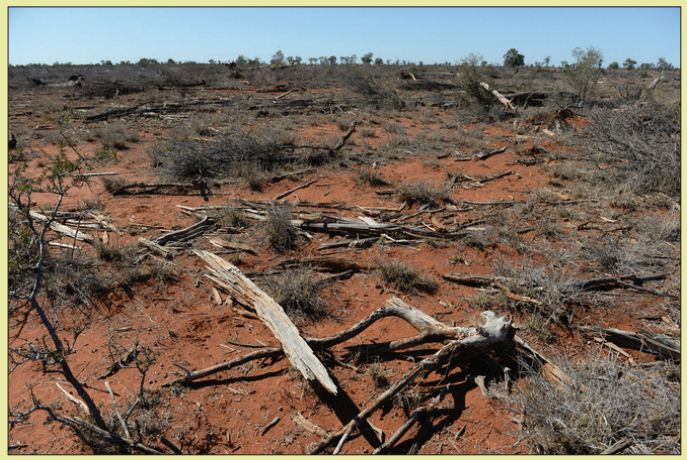
Declining crop yields could put hundreds of thousands of
people at risk for starvation.
Climate change is affecting businesses and economies at home andaround the world.
If action is not taken to curb global carbon emissions, climate change
could cost between 5 and 20 percent of the annual global gross domestic
product, according to a British government report. In comparison, it
would take 1 percent of GDP to lessen the most damaging effects of
climate change, the report says.
These global costs will be felt by local communities and businesses:
• In southern New England lobster catches have plummeted because
of heat stresses and growing parasite threats due to rising sea
temperatures.
• Ski resorts located at the lower altitudes of the Swiss Alps have
difficulty obtaining bank loans because of declining snow.
• In Lake Erie, climate change may significantly lower lake levels,
altering shoreline habitats and costing millions for the relocation
of ports and shore infrastructure.
Globally, more intense hurricanes and downpours could cause billions of
dollars in damage to property and infrastructure. Declining crop yields
due to prolonged drought and high temperatures, especially in Africa,
could put hundreds of thousands of people at risk of starvation.
High sea temperatures also threaten the survival of coral reefs, whichgenerate an estimated $375 billion per year in goods and services.
Model auxiliary verbs
Using: May, could, might
Activity 3
Identify and write modal sentences from the passage predicting what the
future will be like if climate change persists. Compare your sentences
with other classmates.
For exampleIt could be more difficult to grow crops. There might be more droughts.
Describing change in wildlife populations
Activity 1
Discuss this question
If animals migrate to other areas because of climate change, either hot
or cold conditions in which they have not lived before, how does thissituation affect us as human beings?
Listening practice
Activity 2
(Text books closed) Your teacher will read a passage.
Express your opinions and answer the questions that follow.
One-fourth of the Earth’s species could be headed for extinction by 2050
due to climate change.
Rising temperatures are changing weather and vegetation patterns
across the globe, forcing animal species to migrate to new, cooler areas
in order to survive.
The rapid nature of climate change is likely to exceed the ability of many
species to migrate or adjust. Experts predict that one-fourth of the
Earth’s species will be headed for extinction by 2050 if the warming
trend continues at its current rate.
Today, animals are fleeing global warming much faster than they were
less than a decade ago. A study found about 2,000 species are moving
north at a rate of more than 15 feet a day. Climate change appears to
be forcing many of the world’s creatures to migrate to more favourable
locales up to three times faster than previously believed, a study saidon Thursday
Climate Change Impacts: Wildlife at Risk
Extinction of animal species caused by high temperatures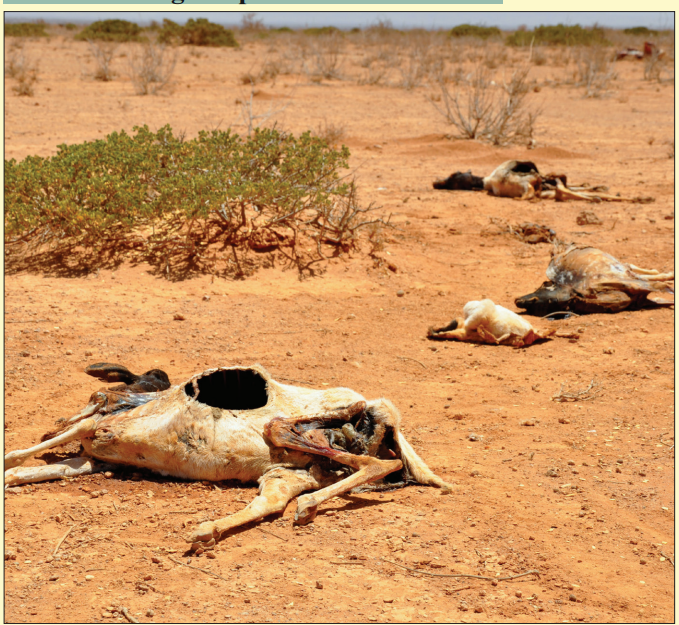
Researchers compiled past studies on species migration and combined
them into a meta-analysis that showed a clear trend towards cooler
climates, with the fastest moves in places where heating was most
intense. “These changes are equivalent to animals and plants shifting
away from the equator at around 20 centimetres per hour, for every hour
of the day, for every day of the year,” said project leader Chris Thomas,
biology professor at the University of York.
“This has been going on for the last 40 years and is set to continue for
at least the rest of this century.”
The study, which appears in the journal Science, was described by York
ecology professor and co-author Jane Hill as “a summary of the state
of world knowledge about how the ranges of species are responding toclimate change”.
“Our analysis shows that rates of response to climate change are two or
three times faster than previously realised,” she said.
The data came from studies of birds, mammals, reptiles, insects, spiders
and plants in Europe, North America, Chile, Malaysia, and South Africa’s
Marion Island.
By grouping the studies together and analysing their results, researchers
found for the first time a link between how hot it was getting and where
organisms were moving.
“This research shows that it is global warming that is causing species
to move towards the poles and to higher elevations,” said lead author
I-Ching Chen, now a researcher at the Academia Sinica in Taiwan.
“We have for the first time shown that the amount by which the
distributions of species have changed is correlated with the amount the
climate has changed in that region.”
Previous studies have suggested that some species are at risk of extinction
due to their change in habitat, but this study did not delve into which
species might be most in peril.
Instead, researchers said they hoped the analysis would give a more
accurate picture of the changes going on across the planet.
“Realisation of how fast species are moving because of climate change
indicates that many species may indeed be heading rapidly towards
extinction, where climatic conditions are deteriorating,” said Thomas.
“On the other hand, other species are moving to new areas where the
climate has become suitable; so there will be some winners as well asmany losers.”
Exercise
Answer these questions about the passage you have listened to.
1. Explain the effects of rising temperatures on animal species.
2. What will happen to most of the Earth’s species by the year 2050
if the warming trend continues?
3. Suggest mitigation measures to reduce the problem in question 3.
4. Compare the mobility levels of animal species today with a decade
ago. Why has this sudden change in the mobility trend happened?
5. Describe the results of research findings scientists found by
grouping the studies together and analysing their data.
6. Account for the risk to extinction of some species according toprevious studies.
Activity 3
Discussion
1. Choose a secretary to report your findings about the question
below to the class.
2. As a learner concerned about environmental and natural resources
conservation in Rwanda, suggest solutions which you think
can avert the concerns described in the passage you listened to.Compare your findings with other members.
Activity 4Vocabulary study
(a) Now open your textbooks. Identify the words in the box belowfrom the passage.
(b) Read the sentences in which they are used.
(c) Share their meanings with a classmate.
(d) Form your own sentences using each word to show that you haveunderstood their meanings.
Present perfect continuous
Activity 1
Work with a classmate
Look at this statement taken from the passage you listened to. Explain
the time the action is being performed.
“This has been going on for the last 40 years and is set to continue
for at least the rest of this century.”In turns discuss its meaning with a classmate.
Activity 2
Read
Read these sentences taken from the reading passage and re-write them
using the present perfect continuous tense as in the example above. Please
do not change their meaning. Compare your answers with other classmates.
1. One-fourth of the Earth’s species could be headed for extinction
due to climate change.
2. Rising temperatures are changing weather and vegetation patterns
across the globe, forcing animal species to migrate to new, cooler
areas in order to survive.
3. Experts predict that one-fourth of the Earth’s species will be
headed for extinction by 2050 if the warming trend continues at
its current rate.
4. Today, animals are fleeing global warming much faster than they
were less than a decade ago.
5. Climate change appears to be forcing many of the world’s creatures
to migrate to more favourable locales up to three times faster than
previously believed, a study said Thursday.
6. Researchers compiled past studies on species migration and
combined them into a meta-analysis that showed a clear trend
towards cooler climates, with the fastest moves in places where
heating was most intense.
7. These changes are equivalent to animals and plants shifting away
from the equator at around 20 centimetres per hour, for every hour
of the day, for every day of the year.
8. Our analysis shows that rates of response to climate change are
two or three times faster than previously realised.
9. Previous studies have suggested that some species are at risk of
extinction due to their change in habitat, but this study did not
delve into which species might be most in peril.
10. Species are moving to new areas where the climate has becomesuitable.
Describing causes
Activity 1
Composition
Use some of the information provided in the passages you read in this unit
to write a descriptive composition about the causes of climate change.
Your composition should not be less than 500 words.
Remember to give a title to your composition, develop the body and
conclude it. Please observe the paragraph structures whenever you are
introducing a new idea
Describing contrast
Using ‘although’, ‘despite’, ‘in spite of’
Read these sentences carefully and discuss their meaning with a
partner.
a) Although species are declining, the gorilla population is increasing.
b) The snow on Kilimanjaro has recently increased despite the global
increase in temperature.
Activity 1
Rewrite the same sentences using:
(a) Despite(b) In spite of
Activity 2
Matching beginnings and endings
Rewrite the following sentences as instructed withoutchanging their meaning.
1. The climate change is already beginning to transform life on
earth, but if we are cautious in our activities, we can reverse the
situation. (use: ‘although’)
2. Seasons are shifting and temperatures are increasing, but if
industries stop polluting the air, gradually normal temperature
conditions can be realised. (Begin: Despite…………)
3. We depend on forests for survival, but we use them faster than we
replace them. (Use: In spite of …………).
4. Industrialists are always warned about the dangers of dumping
refuse in our water sources, but some do not listen. (Start:
Despite………………..)
5. Scientists have warned that we shall all perish from the
surface of the Earth. Some people do not listen to them.
(Begin: Although…………………)
6. The vegetation cover continues disappearing and animals dying.
Poachers continue to kill game or wildlife. (Use ‘despite’)
7. We try our best to plant some trees, but temperatures continue
rising! (Use ‘in spite’)
8. Rising temperatures are changing weather and vegetation
patterns across the globe. Some animals adapt to the new climate
conditions. (Use ‘although’)
9. Although some species have compeletely perished, …………….
(Complete the sentence)
10. …………………….despite the fact that sea levels have risen.
(Complete the sentence).
11. There is lots of drought and floods, but the people somehow
manage to survive. (Use ‘although’)
12. There is little rainfall. We plant drought resistant crops.
(Join the sentences in to one using ‘despite’)
13. We have witnessed minimal temperature changes. This does not
guarantee that we could be affected by drought related illnesses.
(Begin: In spite………..)
14. Scientific research indicates that climate change will cause
hurricanes and tropical storms to become more intense, but we
should stay in our communities. (Use ‘despite’)
15. Extreme heat waves caused more than 20,000 deaths in Europe and
more than 1,500 deaths in India. Surprisingly, people still pollutethe enviroment. (Use ‘Athough …………………)
Activity 3 16.
Form five sentences using ‘although’, despite’, and ‘in spite of’ aboutclimate change. Compare your sentences with those of other classmates.
Describing wildlife protection
Activity 1
Research and report writing
Visit any Non-government Organisation or governmental body concerned
with protecting our environment. Inquire for information regarding the
steps the government is taking to conserve our environment. Write down
notes and then present a full report on your research. Compare your
reports with those of your classmates. For guidelines on how to write
a report, refer to your General Studies and Communication Skills Text
Book, Unit 9: Writing Official Documents and Mass Media for SeniorFive by Fountain Publishers.
Making suggestions about preserving the
environment
Using ‘must’, ‘ought’
Activity 1
Discussion
Discuss the measures that we should take in order to preserve our
environment. Write sentences about those measures using ‘must’ and
‘ought’. Compare your answers with those of other groups.
For example
We must use bicycles more instead of cars.
We ought to use fewer fossil fuels.
